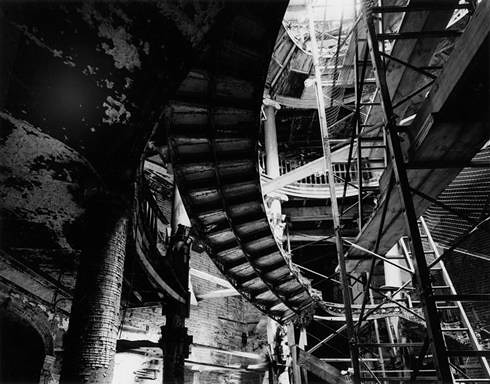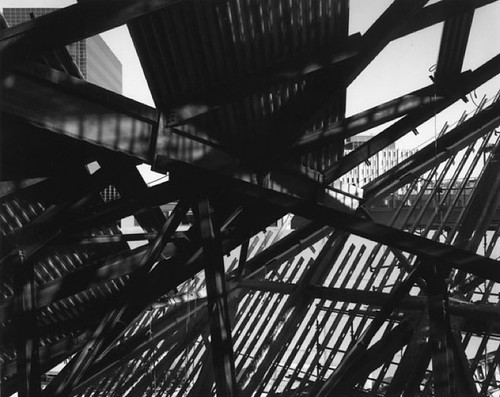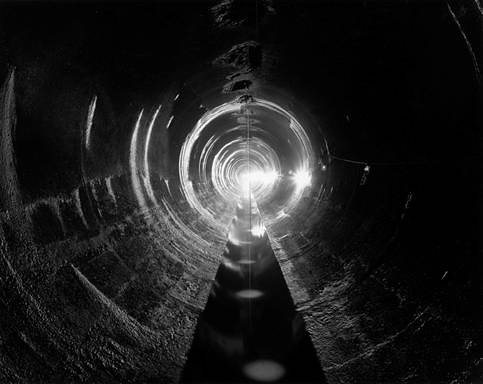The Urban Radiologist

Unfortunately I didn’t get this message out in time for the grand opening, but I wanted to quickly draw your attention to a show that you absolutely must go check out if you are in New York City. My friend and brilliant photographer, Stanley Greenberg, whom I met for the first time at Postopolis! just last year, has filled the Gitterman Gallery with photographs from 4 of his projects spanning the last 15 years.

If you are not familiar with his work then you definitely need to investigate it. I’ve been repeatedly blown away by his images not just for their stark and mysterious urban qualities, but for what they also represent, about breaching borders of what we are allowed and not allowed to see in terms of restricted space, and even how we are to view these places. He shoots underground water drains, the innards of building structures, places of urban secrecy, the hidden and often inaccessible underbelly of cities where buildings and infrastructures quiver in their own nightmares asleep in the dark hollows of night. He photographs a kind of naked urban clandestinism, if you will, and all I can say, is they are SO up our alley, it's ridiculous.
Many of his photographs seem to almost take and show us these gorgeous x-rays of the city, of the subcutaneous architectures that constitute the modern landscape in various morphological states of becoming. There is always this milky bone white structuralism—caught in a web of subterranean light—about the structures that live and breathe among us, I can never seem to get enough of his work. They almost emit their own smells, sounds, full on ambient soundtracks; wood and steel creaking, drain drops, the murmured conversations of massive building laying in wait for something; the sounds of architectural weight.

I think of Stanley as a kind of architectural, or urban radiologist, visually illuminating the marrow of our built world, the shapeliness of its geometrically diverse body parts, the unseen joints of bridges, the quiet heroics of load-bearing walls, the covered tensegrity of the steel and concrete world.
Anyway, see for yourself. Attached is the gallery press release for more details.




FEBRUARY 29 – MAY 10, 2008
GITTERMAN GALLERY
170 EAST 75TH STREET NEW YORK , NY 10021
T 212.734.0868 F 212.734.0869
WWW.GITTERMANGALLERY.COM
Gitterman Gallery is proud to announce our representation of Stanley Greenberg, a contemporary artist we have admired for many years. We will exhibit photographs from his four series of work spanning the last 15 years. The exhibition will open with a reception for the artist on Thursday, February 28th from 6 to 8 p.m. and continue through Saturday, May 10th.
Stanley Greenberg’s work is an investigation of sites often inaccessible to the people they serve. His photographs make us wonder at the extraordinary places that most of us are unaware of and the evolution of technology required to create them. They remind us of how much public space, and the knowledge of it, is now kept from us.
Stanley Greenberg (b. 1956) was born and raised in Brooklyn , New York . After receiving a Bachelor of Arts in Art History from SUNY Stony Brook and a Masters in Public Administration from Syracuse University , he worked in New York City government for most of the 1980s.
Greenberg’s first series explored New York City ’s hidden infrastructure. This work exists both as evidence of our ability to construct a metropolis and as sculptural imagery of mysterious places. At the time, many of these places were difficult to reach, and now it is almost impossible to gain access to them. This project led to the publication of his first two books, Invisible New York: The Hidden Infrastructure of the City, published in 1998 by Johns Hopkins University Press, and Waterworks: A Photographic Journey Through New York’s Hidden Water System,published in 2003 by Princeton Architectural Press.
Greenberg continued to explore unusual and less accessible sites with his next project, construction of contemporary architecture. He was intrigued by the emerging digital technologies that led to innovative designs and building techniques. The skeletons and viscera of the buildings are both intimate and monumental. They reveal the collaborative efforts of the architects, engineers, and construction workers who create the site as much as they remind us of the past and future. In 2005 Greenberg received a Fellowship from the John Simon Guggenheim Foundation to complete this project. A book of the work will be published by the University of Chicago Press in early 2009.
In the summers of 2003 and 2004, Greenberg photographed sand castles at Coney Island and Brighton Beach . Some of these images look like archaeological sites where nature has come to reclaim the land, while others appear to be creations by alien civilizations. They are a reminder of the ephemeral nature of construction, large and small.
Greenberg’s work is included in the collections of the Brooklyn Museum , Los Angeles County Museum of Art, Metropolitan Museum of Art, Museum of the City of New York and Whitney Museum of American Art.
For visuals or further information, please contact us at: 212 734 0868 or info@gittermangallery.com.
Also, check out BLDGBLOG's conversation with Stanley, and also Stanley's Postopolis! presentation on You Tube.







0 Comments:
Post a Comment
<< Home